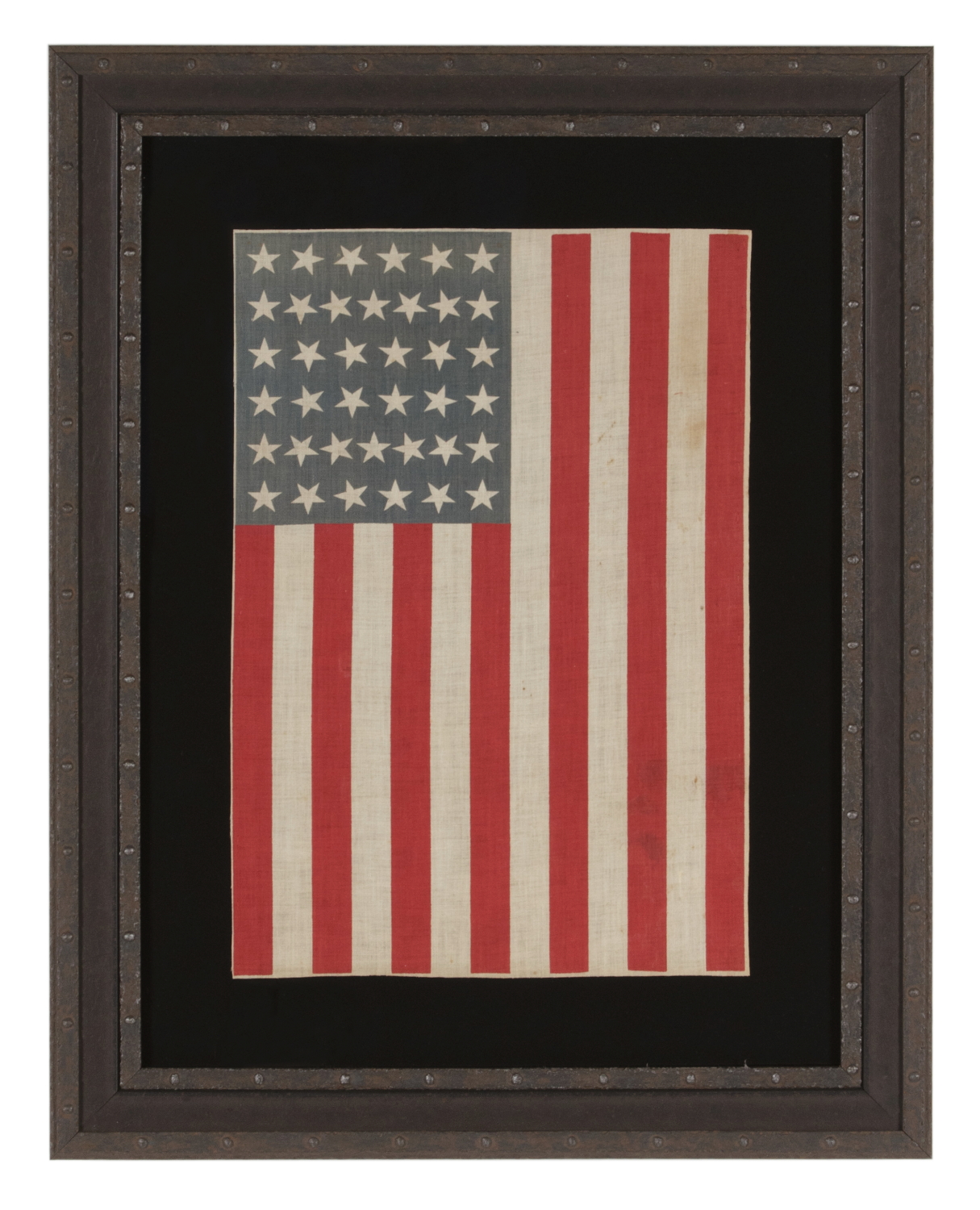
| |
38 STARS WITH SCATTERED STAR POSITIONING, ARRANGED IN COLUMNS OF 6-7-6-6-7-6, COLORADO STATEHOOD, 1876-1889 |
|
| Available: |
Sold |
| Frame Size (H x L): |
26.5" x 21" |
| Flag Size (H x L): |
18" x 12.25" |
|
| Description....: |
|
38 star American national parade flag, printed on plain weave cotton. The stars are arranged in justified columns of 6-7-6-6-7-6, which is a very unusual selection for the 38 star count. Note how the stars in the top and bottom rows are canted, with one arm directed in the 1:00 position, but that the remainder varies throughout in vertical orientation. This adds a nice element of folk quality to the overall design.
Also note how the shape of the stars, while seemingly normal at first glance, actually incorporates a small notch between each arm. This odd trait is shared with a couple of known silk varieties in the 38 and 39 star counts, as well as one other cotton variation with 38 stars.
While many 38 star parade flags have stripes that lean strongly toward orange, these are very much red and typical of the latter 19th century. The canton is a distinctive blue-black, faded slightly to an attractive hue.
Colorado became the 38th state on August 1st, 1876. This was the year of our nation’s 100-year anniversary of independence. Per the Third Flag Act of 1818, stars were not officially added until the 4th of July following a state's addition. For this reason, 37 was the official star count for the American flag in 1876. Flag-making was a competitive venture, however, and few flag-makers would have been continuing to produce 37 star flags when their competitors were making 38’s. It is for this reason that 38 and 13 stars (to represent the original 13 colonies) are more often seen at the Centennial International Exposition, the six-month long World’s Fair held in Philadelphia in honor of the event. Some flag-makers would have been adding a star for the 38th state even before it entered the Union, in the early part of 1876 or even prior. In fact, many makers of parade flags were actually producing 39 star flags, in hopeful anticipation of the addition of two more Western Territories instead of one. But the 39th state would not join the Union for another 13 years, when the Dakota Territory entered as two states on the same day. The 38 star flag became official on July 4th, 1877 and was generally used until the addition of the Dakotas in 1889.
President Ulysses S. Grant was in office when the first 38 star flags would have appeared. The list of presidents serving during the period when the 38 star flag was actually official include Rutherford B. Hayes, James Garfield, Chester Arthur, Grover Cleveland, and Benjamin Harrison.
Mounting: Our in-house conservation department is led by masters degree trained staff. We take great care in the mounting and preservation of flags, as well as many other early textiles, and we have literally mounted thousands of antique flags; more than anyone worldwide. Feel free to contact us for more details on how this particular flag was preserved.
The 3-part frame is constructed of wood, but has a beautiful metallic finish that presents like gunmetal and rusted antique iron. Spacers keep the textile away from the glazing, which is U.V. protective glass.
Condition: There is moderate fading of the canton and minor fading in the red stripes. There is minor foxing and soiling in the lower half of the flag, the most significant of which is light oxidation near the hoist end of the last white stripe. Many of my clients prefer early flags to show their age and history of use. |
|
|
|
| Collector Level: |
Intermediate-Level Collectors and Special Gifts |
|
| Flag Type: |
Parade flag |
|
| Star Count: |
38 |
|
| Earliest Date of Origin: |
1876 |
|
| Latest Date of Origin: |
1889 |
|
| State/Affiliation: |
Colorado |
|
| War Association: |
1866-1890 Indian Wars |
|
| Price: |
SOLD |
|
| |
Views: 2921 |
|
|
|

